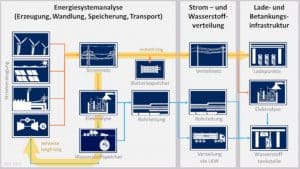
When it comes to the subject of “infrastructure of electric vehicles”, there are many different opinions regarding costs, the possibility of integrating the infrastructure into the power grids and the efficiency of energy supply. Depending on one’s point of view, the infrastructure for battery cars is sometimes better than that for fuel cell cars.
In order to advance the discussion with tangible facts, the Ludwig-Bölkow-Stiftung, supported by Ludwig-Bölkow-Systemtechnik GmbH and Fraunhofer IOSB AST, has published the study “Infrastrukturbedarf E-Mobilität – Analyse eines koordinierten Infrastrukturaufbau zur Versorgung von Batterie- und Brennstoffzellen-Pkw in Deutschland” (Infrastructure Requirement E-Mobility – Analysis of a Coordinated Infrastructure Structure for the Supply of Battery and Fuel Cell Cars in Germany), sponsored by the ADAC Foundation. A broad-based project advisory board accompanied the preparation of the study, which was published in Berlin on 27 June 2019 after about two years of work. Key assumptions and selected results of the study are explained in the following article.
The study considers the infrastructure needed to supply 40 million zero-emission passenger cars in Germany by 2050. Zero-emission passenger cars here are vehicles with battery or fuel cell technology. In addition to the necessary charging and refuelling infrastructure, its integration into the German energy system was also considered. This includes energy distribution (electricity distribution grids and hydrogen supply), energy transport (electricity and hydrogen transport), energy storage (stationary battery and hydrogen storage) and electricity and hydrogen production (see Abb. 1). One focus of the study was a detailed analysis of exemplary electricity distribution grids.
A total of three scenarios were considered, each with a different proportion of battery and fuel cell vehicles. In the “Focus BEV” scenario, 80 percent of the zero-emission fleet has a battery electric drive available, the remaining 20 percent uses fuel cell technology. In the “Focus FCEV” scenario, the proportion of vehicles with fuel cells is 80 percent, while the proportion of battery vehicles is now 20 percent. In the “mix” scenario, both drive technologies account for 50 percent each. In addition to the 2050 target year, the 2030 and 2040 support years were also considered. However, the following remarks are limited to the target year 2050.
Charging points and hydrogen filling stations
The need for charging points to supply battery cars was determined on the basis of figures from the former National Platform for Electric Mobility (NPE). Depending on the scenario, between 9.6 (focus FCEV) and 38.4 million (focus BEV) charging points are required for 2050. The associated annual costs for maintenance, servicing and investment depreciation are between EUR 2 billion in the focus FCEV scenario and just under EUR 9 billion in the focus BEV scenario. The private charging points, which were assumed to cost an average of 1,650 euros each (hardware including planning, grid connection and installation), have a significant influence on the costs.
…
read more in H2-international October 2019
Authors:
Dr. Jan Michalski, Jan Zerhusen, Dr. Ulrich Bünger, Dr. Werner Zittel,
all four Ludwig-Bölkow-Systemtechnik GmbH (LBST), Ottobrunn, Germany
Steffen Nicolai, Samir Kharboutli, Cristian Monsalve, Stephan Ruhe,
all four Fraunhofer Institutes for Optronics, Systems Engineering and Image Evaluation, Karlsruhe

























0 Comments